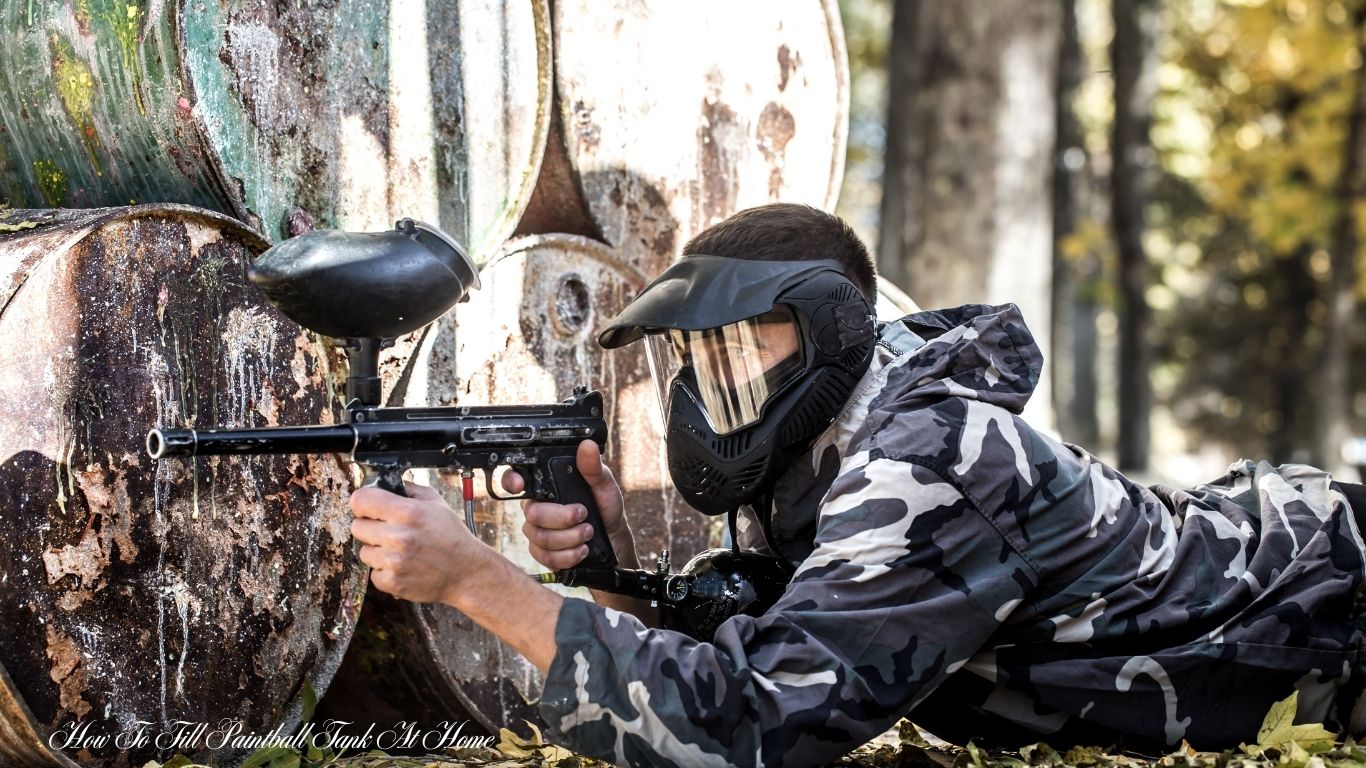For any paintball enthusiast, there’s no greater satisfaction than heading out for a game with your tank fully charged, ready for action. But what happens when you’re tired of making the trek to your local store for a refill? Knowing how to fill a paintball tank at home is the answer. Not only does it save you time and money, but it also gives you the flexibility to refill your tank whenever needed. Whether you’re a seasoned player or just starting, this step-by-step guide will teach you how to refill your paintball tank at home with ease.
Filling your paintball tank correctly is not just about convenience—it’s a skill that will improve your overall experience in the sport. With a bit of guidance and the right paintball equipment, you’ll be able to fill your tank safely and efficiently. In this guide, we’ll cover everything from understanding your tank’s specifications to the process of filling and ensuring safety during the process. Ready to learn how to keep your paintball gear in top shape? Let’s dive in!
Understanding Paintball Tanks and the Equipment You Need
Before you can confidently fill a paintball tank at home, it’s essential to familiarize yourself with the types of tanks available and the tools necessary for the job. While it’s easy to overlook the intricacies of your tank, having the right equipment and understanding its components will make your refilling experience much smoother.
CO2 Tanks and HPA (High-Pressure Air) Tanks are the two main types of tanks used in paintball. CO2 tanks are commonly found in entry-level paintball guns. They are generally affordable and easy to find, making them a great option for beginners. However, CO2 tanks have one downside—they perform less reliably in extreme weather conditions, especially cold temperatures, which can cause pressure inconsistencies. HPA tanks, on the other hand, are preferred by experienced players due to their more stable performance in different conditions. These tanks are filled with compressed air and typically operate at 3000 or 4500 PSI (pounds per square inch), making them more efficient in the long run.
Now, let’s talk about the equipment you’ll need to refill your tank. At home, you’ll require either a high-pressure air compressor or a scuba tank to fill your paintball tank. Regular air compressors simply don’t have the power to generate the necessary PSI. If you’re looking for a reliable way to fill your HPA tank, a scuba tank with a fill station is a great option. For CO2 tanks, you’ll need a different setup, often involving a CO2 tank refill adapter. The setup for filling can sound complicated at first, but once you understand the equipment and process, it becomes second nature. Let’s move forward with the essential steps you’ll need to follow.
How to Fill Your Paintball Tank at Home: A Step-by-Step Guide
Filling a paintball tank at home is easier than it seems, but it’s important to approach the task with patience and precision. The process can be broken down into a series of manageable steps, ensuring you fill your tank safely and effectively every time. Below, we’ll guide you through each step.
Step 1: Check the Current Tank Pressure
Before you even think about starting the refill process, it’s vital to check your paintball tank’s current pressure. Most tanks have a pressure gauge, which will display the PSI of the tank. You’ll want to ensure that the tank isn’t completely empty before refilling it. It’s always better to top off the tank rather than overfill it, which can cause pressure issues. If your tank’s PSI is significantly low, you’re in the right place to begin the refill process.
Step 2: Set Up Your Equipment Properly
Once you’ve checked your tank, it’s time to set up your equipment. If you’re using a scuba tank or a high-pressure compressor, make sure that it’s full and in proper working condition. Attach your fill station or adapter to the air source. This component is responsible for connecting your paintball tank to the air compressor or scuba tank. Make sure the connections are secure to prevent leaks during the process. It’s crucial that no air escapes, as even a small leak can cause safety issues and an incomplete refill.
Step 3: Begin the Filling Process
Now that everything is set up, you can start the filling process. Slowly open the valve on your air source. You should hear air flowing into your tank. Keep a close eye on your paintball tank’s pressure gauge while filling. You want to gradually increase the PSI but be careful not to rush the process. Overfilling can cause the tank to burst, leading to dangerous consequences. Filling your tank slowly also ensures that you’re not wasting air and that the tank reaches its optimal pressure efficiently.
Step 4: Stop When the Tank Reaches the Recommended PSI
As the air fills your tank, watch the gauge carefully. Most paintball tanks have a recommended PSI range—typically around 3000 PSI for HPA tanks. Once the needle reaches the appropriate PSI, it’s important to stop filling. Overfilling a tank can result in damage to the tank, pressure regulator, or the paintball gun itself. If you’re using a CO2 tank, the pressure may vary depending on the tank size, so always consult the manufacturer’s guidelines for the right PSI.
Step 5: Disconnect and Test the Tank
After the tank is filled, slowly close the valve of your air source and carefully disconnect your fill station or adapter. At this point, it’s essential to test the tank to ensure it’s functioning properly. Attach it to your paintball marker and fire a few test shots. If the shots are strong and consistent, the tank is ready for use.
Safety Precautions When Refilling a Paintball Tank
While filling your paintball tank at home is convenient, it’s essential to follow safety guidelines to avoid accidents. Here are some important safety tips to keep in mind:
- Wear Safety Gear: Always wear safety goggles and gloves when refilling your tank to protect yourself from potential air leaks or mishaps.
- Inspect Your Equipment: Before starting the process, thoroughly check the condition of your paintball tank, fill station, and air source. Look for any cracks, leaks, or damage that could cause problems during the filling process.
- Refill in a Ventilated Area: If you’re using CO2, ensure you’re in a well-ventilated area to avoid the buildup of CO2 gas. This is especially important when dealing with CO2 tanks, as they can release gas during the filling process.
- Use the Correct Tools: Never attempt to use a regular air compressor. Always use high-pressure air compressors or scuba tanks to ensure you’re filling your paintball tank correctly.
Common Issues While Filling Your Paintball Tank and How to Fix Them
Even though filling a paintball tank is straightforward, issues can arise. Here’s a breakdown of the most common problems and how to resolve them:
Problem: Overfilling Your Tank
Overfilling your paintball tank is a major issue, as it can lead to dangerous outcomes. To avoid this, always monitor the PSI gauge and slow down the process if it’s nearing the maximum PSI.
Problem: Air Leaks
Air leaks are often caused by loose connections or damaged O-rings. If you detect a leak, immediately stop the process and check all connections. Replace any damaged seals or components before continuing.
Problem: Low Pressure After Filling
If your tank doesn’t seem to reach the correct pressure after filling, check for leaks or damage to the valve. Sometimes, improper connections or faulty equipment can cause the tank to be underfilled.
FAQs
Q: How do I know when my paintball tank is full?
A: You can check the PSI on your tank’s gauge. When it reaches the recommended PSI (usually around 3000 PSI for HPA tanks), the tank is full.
Q: Can I use a regular air compressor to fill my paintball tank?
A: No, regular air compressors don’t have the necessary PSI levels for paintball tanks. You need a high-pressure air compressor or a scuba tank.
Q: Is it safe to fill my paintball tank at home?
A: Yes, as long as you follow the proper safety precautions and use the right equipment, filling your paintball tank at home is safe.
Q: What should I do if I accidentally overfill my paintball tank?
A: If you overfill your tank, slowly release some of the air by loosening the valve until the PSI is within the safe range.
Q: How long does it take to fill a paintball tank at home?
A: Filling a paintball tank typically takes around 3-5 minutes, depending on the pressure and the size of the tank.
Conclusion
Filling your paintball tank at home is an incredibly rewarding skill that can save you time and money. By understanding your tank type, using the right equipment, and following the proper procedure, you can easily refill your tank and be ready for your next paintball session. Remember to always prioritize safety, check for any leaks or damage, and never rush the process. With these tips and steps, you’ll be filling your paintball tank like a pro in no time.


Leave a Reply